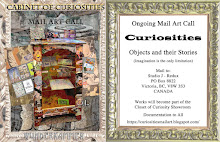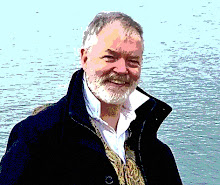On Art: Victoria curator invites 30 artists to create their own versions of one work
Dale Roberts's felted version of Gerhard Richter’s abstract painting. Photograph by: Handout
Efren Quiroz is a constant presence on the Victoria art scene. He shows up at almost every art opening with his video camera and, in his quiet way, offers the artists a chance to have their say. Quiroz records all the artworks, and then posts this information on his website, Exhibit-V.ca. He has, over the past five years, personally created an inclusive document of the art world of Victoria.
Recently, Wendy Welch, director of the Vancouver Island School of Art, invited Quiroz to curate an exhibition at the school. It was his first time, and he makes no pretense to any deep knowledge of art. But he knew he wanted to create a group activity that would be fun and fresh, and result in people making new things. He decided to ask artists to make a work of art based on another work of art. His friend, painter Brad Passuti, gave him ideas and together they sought out the work of German modern master Gerhard Richter on the Internet. Eventually Quiroz chose a colourful and vigorous abstract from the 1980s — “because it looked interesting.”
“Since I know many people from different styles of art,” he told me, “I invited five or six from this, from that, and put them together. The art world is so cliquey, they don’t interact with each other. From all these groups I wanted to put them together, just this once. That was the main idea.”
His list included both established artists such as Jim Gordaneer and Phyllis Serota and emerging artists like Pete Kohut. He contacted 30 artists by email, and asked each to create something 30 inches square.
In a book about Richter, he found a phrase about difference and repetition — even if you try, you can never actually do the same thing twice. He used the phrase for the name of the show, though Quiroz admitted: “Of course, I have never read the book. I tried, the first page. You have to be into philosophy and everything.
“I wanted the artists to work by themselves and do what they can do,” he said. Though not a painter himself, he understands that artists love to try new things. They thrive on challenge and exploration. He didn’t tell anyone who else was invited and while a few refused to participate, others heard of the show and demanded to be included. Quiroz acceded to all their wishes. The show was arranged with just four group emails.
People told him that the work wouldn’t show up on time, if at all. But, on the appointed day, all 30 artists delivered their work to the School of Art. Quiroz took it in, locked the gallery door, and hung it up. Closest to the door are the artworks that least resemble the Richter painting. Harry Stanbridge created a portrait of Richter. Victoria Edgar’s etching makes a slight reference, in reverse, to the painting’s composition. Next are collages and landscapes and pointillist evocations. Along the far wall are grouped eight squares which share the colours and composition of the original. Up close, they are as varied as can be.
At a pre-opening party for the artists, before the public was allowed in, there was much marvelling and many new acquaintances. The video camera was passed from hand to hand, and before long the show appeared on Facebook. Party pictures abound, and many of the artists wrote of their joys and sorrows as they wrestled with the task. A number recorded short videos sharing insights. Beginning with the same initial premise, each mounted his or her hobby horse and rode merrily into the sunset, some profoundly intellectual and some happily confused. Even without seeing the artworks, this site is a fascinating snapshot of current concerns.
I recommend a visit. The show is too big and too complex capture in this column so, to illustrate it, I chose just one. Dale Roberts made what I assumed, from across the room, was a dazzling if blurry oil painting of the Richter piece. On closer inspection, I was amazed to discover it was three-dimensional and made of fibres by his unique felting process.
“I didn’t do it to judge,” Quiroz concluded. “The main thing was to have people together. A little bit of adventure. Maybe I tricked them a little bit. Egos were not involved.”
Difference and Repetition: 30 works that respond to Gerhard Richter’s Abstract Painting 587-5 (1985), at the Vancouver Island School of Art, 2549 Quadra St., 250-380-3500. Until Dec. 2.
© Copyright 2013
Needle felted wool, styrofoam
30" x 30" x 6"
The 3rd study in this experiment of repetition based on the work of Gerhard Richter.
----------------------------------------------------
"Difference and Repetition" an exhibition which derives its title from the book of the same name by French philosopher Gilles Deleuze, explores Deleuze’s concept of how a new series brings back an older series and transforms it into something completely new, so that repetition brings about difference.
30 artists from diverse backgrounds and working independently from one another will be contributing one unit (of exactly the same size) in a series derived from a single source - "Abstract painting (1985) 587-5" by the German artist Gerhard Richter. Richter’s work is in a sense itself a series; however in his case a series of unpredictable chaotic and gestural actions resulted in a single work which is impossible to recreate accurately. His series within a single work (Abstract painting (1985) 587-5) will itself be transformed into a new series consisting of 30 original works. Exhibit runs from Nov. 1 to Dec. 2, 2013 Opening Reception: Friday Nov. 1 @ 7 : 30 pm Slide Room Gallery 2549 Quadra st. |








